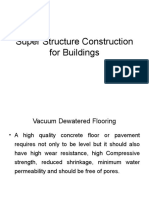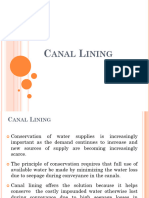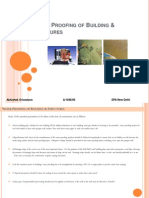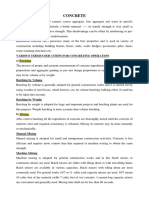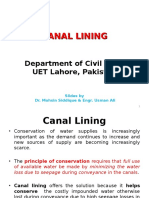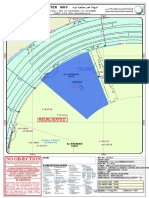0 ratings0% found this document useful (0 votes)
44 viewsIndex 2
Index 2
Uploaded by
dandekarvaibhavVacuum dewatered flooring involves laying concrete and then using a vacuum pump and suction mat to remove up to 25% of the water, lowering the water-cement ratio and improving the concrete's properties. This results in floors that are monolithic, shrinkage-free, and have high strength, wear resistance, and quality. The process allows for higher slump concrete that is easier to pour and work with, while still achieving the benefits of a lower water-cement ratio through the vacuum dewatering. Vacuum dewatered flooring has been used successfully in India for over 14 years on millions of square meters of projects.
Copyright:
Attribution Non-Commercial (BY-NC)
Available Formats
Download as PDF, TXT or read online from Scribd
Index 2
Index 2
Uploaded by
dandekarvaibhav0 ratings0% found this document useful (0 votes)
44 views1 pageVacuum dewatered flooring involves laying concrete and then using a vacuum pump and suction mat to remove up to 25% of the water, lowering the water-cement ratio and improving the concrete's properties. This results in floors that are monolithic, shrinkage-free, and have high strength, wear resistance, and quality. The process allows for higher slump concrete that is easier to pour and work with, while still achieving the benefits of a lower water-cement ratio through the vacuum dewatering. Vacuum dewatered flooring has been used successfully in India for over 14 years on millions of square meters of projects.
Copyright
© Attribution Non-Commercial (BY-NC)
Available Formats
PDF, TXT or read online from Scribd
Share this document
Did you find this document useful?
Is this content inappropriate?
Vacuum dewatered flooring involves laying concrete and then using a vacuum pump and suction mat to remove up to 25% of the water, lowering the water-cement ratio and improving the concrete's properties. This results in floors that are monolithic, shrinkage-free, and have high strength, wear resistance, and quality. The process allows for higher slump concrete that is easier to pour and work with, while still achieving the benefits of a lower water-cement ratio through the vacuum dewatering. Vacuum dewatered flooring has been used successfully in India for over 14 years on millions of square meters of projects.
Copyright:
Attribution Non-Commercial (BY-NC)
Available Formats
Download as PDF, TXT or read online from Scribd
Download as pdf or txt
0 ratings0% found this document useful (0 votes)
44 views1 pageIndex 2
Index 2
Uploaded by
dandekarvaibhavVacuum dewatered flooring involves laying concrete and then using a vacuum pump and suction mat to remove up to 25% of the water, lowering the water-cement ratio and improving the concrete's properties. This results in floors that are monolithic, shrinkage-free, and have high strength, wear resistance, and quality. The process allows for higher slump concrete that is easier to pour and work with, while still achieving the benefits of a lower water-cement ratio through the vacuum dewatering. Vacuum dewatered flooring has been used successfully in India for over 14 years on millions of square meters of projects.
Copyright:
Attribution Non-Commercial (BY-NC)
Available Formats
Download as PDF, TXT or read online from Scribd
Download as pdf or txt
You are on page 1of 1
EPA Infrastructure
Tremix (Vacuum Dewatered) Flooring Overview
A high quality concrete floor or pavement requires not only to be level but it should also have high wear resistance, high compressive strength, reduced shrinkage, minimum water permeability and should be free of pores. The following paragraphs explain the method and benefits of this process. Why use Vacuum Dewatered flooring? The Vacuum Dewatered (VD) Flooring method, is a system for laying high quality concrete floors with superior costeffectiveness. The key to the use of this method is the dewatering of concrete by vacuum process surplus water from the concrete is removed immediately after placing and vibration, reducing the water: cement ratio to an optimum level. Therefore, adopting the VD Flooring method facilitates use of concrete with better workability than what is normally possible. A lowered water to cement ratio due to vacuum dewatering leads to improvement in each of the concrete properties listed above. The Procedure The method involves laying the floor in the following sequence: - Concreting in the conventional way but with a higher slump so that workability is good and concrete pouring and spreading is done fast. - Poker Vibration (specially on both sides of the panel) is always essential for floor thickness of 100 mm and above. - Surface Vibration using Double Beam Surface Vibrator. - Levelling the vibrated surface with a straight Edge. - Vacuum Dewatering using Vacuum Pump and Suction Mat Top Cover & Filter Pads. - Floating and Trowelling of the concrete pavements using Skimfloaters. The Benefits Through the vaccum treatment, it is possible to reduce the water content in the concrete by 15 – 25% which greatly increases the compressive strength. Thus, by lowering the water/ cement ratio, the tendency of shrinkage and subsequent cracking is greatly reduced. Lowest water/ cement ratio being at the top part of a vacuum dewatered slab, gives it the maximum compressive strength. Since the water/ cement ratio is lowered through vacuum dewatering, concrete of higher initial slump can be used while pouring. This greatly simplifies the job of mixing and pouring concrete. The operational convenience this technology offers, can be very simply put as pouring concrete having higher water/ cement ratio giving excellent workability and removing the excess water immediately after surface vibration, resulting in a zero slump concrete. The vacuum treated concrete floor/ pavement, exhibits inherent advantages viz: - Monolithic, Shrinkage free pavements. - Single panel without joints up to 100 sq. meters. (depending on design specifications) - Very high splitting strength. - Very high quality pavements in terms of strengths i.e. compressive, abrasion, flexural etc. - Saving in cement since the compressive strength of the pavement is increased giving flexibility to adopt either leaner mix or design a slab of lesser thickness giving the required strength. - Controlled and uniform surface finish. - Very high output exceeding 100 200 sq. meters. in a day (depending upon the configuration of Vacuum Dewatering System and other site conditions like concrete mixing and pouring speed). History of This Procedure The Vacuum Dewatered Concrete Flooring technology has been employed in many projects in the country during last 14 years and more than 10 million sq. meters. of work has been carried out. The VD System is increasingly being accepted as a relevant and totally adaptable technology in the Indian environment. It is now being specified by many leading Architects and Consulting Engineers for their projects.
http://epa-infrastructure.com
Powered by Joomla!
Generated: 15 November, 2011, 10:40
You might also like
- API - 571 - 2020 - JonasDocument71 pagesAPI - 571 - 2020 - Jonasjonaspathrose100% (2)
- TREMIX FLOORING (For Car Park and Drive Way) : Method StatementDocument12 pagesTREMIX FLOORING (For Car Park and Drive Way) : Method Statementmukesh sharma100% (3)
- Vacuum Dewatering FlooringDocument4 pagesVacuum Dewatering FlooringArunava Das100% (1)
- Purvi Enterprises: Detailed Project ReportDocument19 pagesPurvi Enterprises: Detailed Project Report8897477809No ratings yet
- BomDocument73 pagesBomManuelito ZapataNo ratings yet
- Super Structure Construction For BuildingsDocument12 pagesSuper Structure Construction For BuildingsHari KumarNo ratings yet
- VDF Flooring - SlideshareDocument6 pagesVDF Flooring - SlideshareAshik Rehmath Parambil0% (1)
- Vacuum Dewaterimg: New Way For Concrete Flooring by Tremix MethodDocument7 pagesVacuum Dewaterimg: New Way For Concrete Flooring by Tremix Methodsachinkarape4844No ratings yet
- Mad RascalDocument23 pagesMad RascalRahul RathodNo ratings yet
- Vaccum Dewatering Flooring ServiceDocument2 pagesVaccum Dewatering Flooring Servicesunkapaka prashanthNo ratings yet
- Underwater ConcretingDocument6 pagesUnderwater Concretingnepomucenoanne13No ratings yet
- Vacuum Dewatering SystemDocument3 pagesVacuum Dewatering Systemchawla202088190% (1)
- Vaccum DewateringDocument21 pagesVaccum DewateringArdra RavindranNo ratings yet
- Vacuum Concreting: Advantages-Techniques With EquipmentsDocument9 pagesVacuum Concreting: Advantages-Techniques With EquipmentsnadirshahNo ratings yet
- Vacuumconcrete 190731131507Document19 pagesVacuumconcrete 190731131507Arunkumar CHNo ratings yet
- Vacuum Dewaterimg: New Way For Concrete Flooring by Tremix MethodDocument8 pagesVacuum Dewaterimg: New Way For Concrete Flooring by Tremix Methodtushar satamNo ratings yet
- 12-1-Canal LiningDocument33 pages12-1-Canal LiningcivilengineerassadullahNo ratings yet
- Types of ConcreteDocument36 pagesTypes of ConcreteRacquel NacinoNo ratings yet
- SRDocument4 pagesSRnadirshahNo ratings yet
- 3-Materials For Precast ProductionDocument37 pages3-Materials For Precast Productionpooja apteNo ratings yet
- Water Reducing AdmixtureDocument2 pagesWater Reducing AdmixtureBryanMatthewLontokNo ratings yet
- VDFDocument22 pagesVDFAyush SharmaNo ratings yet
- Concete TechnologyDocument24 pagesConcete Technologyአዲስ አዲስNo ratings yet
- Vacuum de - Watered Flooring Method Statement: ActivitiesDocument1 pageVacuum de - Watered Flooring Method Statement: Activitiesவினோத் குமார்No ratings yet
- Vacuum de - Watered Flooring Method Statement: ActivitiesDocument1 pageVacuum de - Watered Flooring Method Statement: ActivitiesISPRO TVNo ratings yet
- No Fines Conc SpecsDocument3 pagesNo Fines Conc Specsway2saleemNo ratings yet
- Abstract:: Mix Proportioning Troweling Vacuum-Treated Concrete Water-Cement Ratio Water ContentDocument2 pagesAbstract:: Mix Proportioning Troweling Vacuum-Treated Concrete Water-Cement Ratio Water ContentnadirshahNo ratings yet
- 05 Cementing MaterialsDocument38 pages05 Cementing MaterialsAri CalmNo ratings yet
- Ce2071 - Repair and Rehablitation of Structures (For Viii - Semester)Document15 pagesCe2071 - Repair and Rehablitation of Structures (For Viii - Semester)Abera MamoNo ratings yet
- BOQ WaterproofingDocument6 pagesBOQ WaterproofingShashi Bhushan SinghNo ratings yet
- Civil Engineering Interview Questions and Answers - Part 4 PDFDocument2 pagesCivil Engineering Interview Questions and Answers - Part 4 PDFSiva2sankarNo ratings yet
- Ground Bearing Concrete Slabs - Chapter 2Document37 pagesGround Bearing Concrete Slabs - Chapter 2share4learn100% (1)
- Waterproofing in ToiletDocument11 pagesWaterproofing in ToiletchaityaNo ratings yet
- Water Proofing of Building & StructuresDocument12 pagesWater Proofing of Building & StructuresAnshumali Baruah100% (1)
- Basement WaterproofingDocument11 pagesBasement WaterproofingRicha Shah100% (1)
- Vacuum DewaterDocument16 pagesVacuum DewaterSrinivas B VNo ratings yet
- Water Proofing MethodologyDocument6 pagesWater Proofing Methodologykartick adhikaryNo ratings yet
- Ubond ShieldDocument7 pagesUbond ShieldtripanNo ratings yet
- Concrete PavementDocument7 pagesConcrete PavementBori GeorgeNo ratings yet
- Emerging Lecture 2Document38 pagesEmerging Lecture 2Meron BerihunNo ratings yet
- Construction Procedures of Slip-Form PavementDocument5 pagesConstruction Procedures of Slip-Form PavementSerdarNo ratings yet
- Tarmac Permeable Concrete Solution GuideDocument34 pagesTarmac Permeable Concrete Solution GuidesiongloongNo ratings yet
- Concrete NotesDocument4 pagesConcrete NotesdaleemaNo ratings yet
- Concrete: Various Terms Used / Steps For Concreting Operation A) BatchingDocument5 pagesConcrete: Various Terms Used / Steps For Concreting Operation A) BatchingDARK KnightNo ratings yet
- A Guide For Durable Quality Residential Concrete Flatwork 2016 RevisionDocument4 pagesA Guide For Durable Quality Residential Concrete Flatwork 2016 RevisionMICHAELNo ratings yet
- Assignment On Vacuum ConcreteDocument10 pagesAssignment On Vacuum ConcretesoujanyaNo ratings yet
- Emerging Lecture TwoDocument53 pagesEmerging Lecture Twoizim izimNo ratings yet
- Starting A New Business?: TOPKEN Silica Fume (P.R.C)Document5 pagesStarting A New Business?: TOPKEN Silica Fume (P.R.C)Muhafeez GoolabNo ratings yet
- External PavingDocument30 pagesExternal PavingVarunNo ratings yet
- Soil Stabilization: Benefits CostDocument5 pagesSoil Stabilization: Benefits CostMizs' DewieNo ratings yet
- ConsmatDocument14 pagesConsmatjohny BavitoNo ratings yet
- Canal LiningDocument32 pagesCanal LiningAhsan LatifNo ratings yet
- Module 6 - High Performance Concretes PDFDocument32 pagesModule 6 - High Performance Concretes PDFabinash choudharyNo ratings yet
- Car ParkDocument2 pagesCar Parkchithirai10No ratings yet
- CIP 38 - Pervious ConcreteDocument2 pagesCIP 38 - Pervious ConcreteHyunkyoun JinNo ratings yet
- Self Compacting ConcreteDocument18 pagesSelf Compacting ConcreteKannan KandappanNo ratings yet
- Concrete CanvasDocument20 pagesConcrete CanvasJet Espejon Javier100% (1)
- Vacuum Dewatered Flooring: Mr. Kandavel Raja PDocument60 pagesVacuum Dewatered Flooring: Mr. Kandavel Raja PKandavelrajaNo ratings yet
- 2013 Ud Elective Ashok BhairiDocument12 pages2013 Ud Elective Ashok BhairivaishnaviNo ratings yet
- Sewage Disposal Works: Their Design and ConstructionFrom EverandSewage Disposal Works: Their Design and ConstructionNo ratings yet
- Splashwall Bathrooms 2021 LowResDocument19 pagesSplashwall Bathrooms 2021 LowResday69walkerNo ratings yet
- Product Made in Qatar: Manufacturer'S Test CertificateDocument1 pageProduct Made in Qatar: Manufacturer'S Test CertificateQc QatarNo ratings yet
- Water Meter Room Regulations From DEWADocument34 pagesWater Meter Room Regulations From DEWASANRAJ TECHNONo ratings yet
- Precast, Prestressed Concrete BridgesDocument24 pagesPrecast, Prestressed Concrete BridgesTeodora PopovicNo ratings yet
- MEISER Grating PDFDocument136 pagesMEISER Grating PDFEngr Qaisar NazeerNo ratings yet
- Boq For 3bedroom Penthouse Foundation Without DPC Dyitkuka Updated 09 July 2024Document2 pagesBoq For 3bedroom Penthouse Foundation Without DPC Dyitkuka Updated 09 July 2024Umezurike Stephen KelechiNo ratings yet
- Pengaruh Penambahan Serat Bambu Terhadap Kuat Tarik Dan Kuat Tekan BetonDocument6 pagesPengaruh Penambahan Serat Bambu Terhadap Kuat Tarik Dan Kuat Tekan Betonmuhajir mrbNo ratings yet
- Bill of MaterialsDocument2 pagesBill of MaterialsGicco CastorNo ratings yet
- Jindal Panther PDFDocument11 pagesJindal Panther PDFAmiy SrivastavaNo ratings yet
- The Effect of The Using Waste Marble Dust As FineDocument10 pagesThe Effect of The Using Waste Marble Dust As Finekyle encarnacionNo ratings yet
- Gtu SyllabusDocument5 pagesGtu SyllabussanjayNo ratings yet
- Manufacturing Technology 3rd Edition R. L. Timings 2024 Scribd DownloadDocument64 pagesManufacturing Technology 3rd Edition R. L. Timings 2024 Scribd Downloadkiranatitoko100% (2)
- Effect of Pressure Testing On Carbon Steel MicrostructureDocument9 pagesEffect of Pressure Testing On Carbon Steel Microstructurerosli2503No ratings yet
- Deflection Considerations in Two-Way Reinforced CoDocument13 pagesDeflection Considerations in Two-Way Reinforced CoHamid HassanzadaNo ratings yet
- Final Project Report Phase 1Document42 pagesFinal Project Report Phase 1gaurav salmutheNo ratings yet
- API RP 572 QuizDocument17 pagesAPI RP 572 Quizamalhaj2013No ratings yet
- Quantity Sheet BCEDocument6 pagesQuantity Sheet BCEIsha MancenidoNo ratings yet
- Joint Technology Update No. 10: Sspc/PcsiDocument24 pagesJoint Technology Update No. 10: Sspc/PcsiHUGONo ratings yet
- Structural Steel Design L 03A-19.11.2021Document74 pagesStructural Steel Design L 03A-19.11.2021LUGHANO NGAJILONo ratings yet
- ÍTEM 2. - MINEFLEX Hose - ESPECIFICACIONES TÉCNICAS - FLUIDOSDocument3 pagesÍTEM 2. - MINEFLEX Hose - ESPECIFICACIONES TÉCNICAS - FLUIDOSGiancarloNo ratings yet
- Datag For Print-Details2Document1 pageDatag For Print-Details2Jay Will MaguindaNo ratings yet
- CFV Foot ValveDocument1 pageCFV Foot ValveAgung YudistiraNo ratings yet
- GI-Specs For HandbookDocument1 pageGI-Specs For HandbookNrjNo ratings yet
- A48Document6 pagesA48Luis Fernando LaverdeNo ratings yet
- Commercial Toilet Details - Pankaj PrabhakarDocument1 pageCommercial Toilet Details - Pankaj PrabhakarVinita KumariNo ratings yet
- Hempaline Internal Use OnlyDocument2 pagesHempaline Internal Use OnlyMohamed NouzerNo ratings yet
- Aluminum Composite Panels With Nano-Self Cleaning TechnologyDocument7 pagesAluminum Composite Panels With Nano-Self Cleaning TechnologymaeNo ratings yet
- The Effects of Water Backing On SA106Gr. B Pipe WeldsDocument8 pagesThe Effects of Water Backing On SA106Gr. B Pipe WeldschethanNo ratings yet





